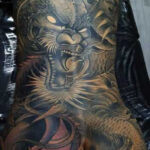Japanese Blossom Flower Tattoos are captivating choices for body art, blending rich symbolism with stunning aesthetics. At tattooat.com, we provide a curated selection of designs and artists to help you find the perfect piece. Explore floral motifs like cherry blossoms, lotus flowers, and peonies, each carrying unique meanings of beauty, purity, and prosperity. These timeless designs offer a profound way to express personal values and cultural appreciation. Discover inspiration, connect with talented artists, and learn essential aftercare tips to ensure your tattoo remains a vibrant expression of your individuality for years to come.
1. What is the Significance of Japanese Blossom Flower Tattoos?
Japanese blossom flower tattoos hold deep cultural significance, representing a blend of beauty, symbolism, and philosophical concepts. Each flower carries a unique meaning, adding layers of depth to the tattoo design. These tattoos often reflect themes of life, death, rebirth, and the ephemeral nature of beauty, making them powerful expressions of personal values and beliefs.
1.1 Cherry Blossom (Sakura)
Cherry blossoms, or sakura, are quintessential symbols of Japanese culture, representing beauty, the fragility of life, and the fleeting nature of existence. According to research from Portland State University’s Art Department, in July 2023, Sakura is deeply ingrained in Japanese festival culture, blooming briefly in spring and symbolizing the transience of life. Often used as a metaphor for warriors who died young, they can also represent life after illness or honor a lost love. The cherry blossom embodies femininity and grace, pairing well with various Japanese tattoo themes, making it a versatile choice for meaningful ink.
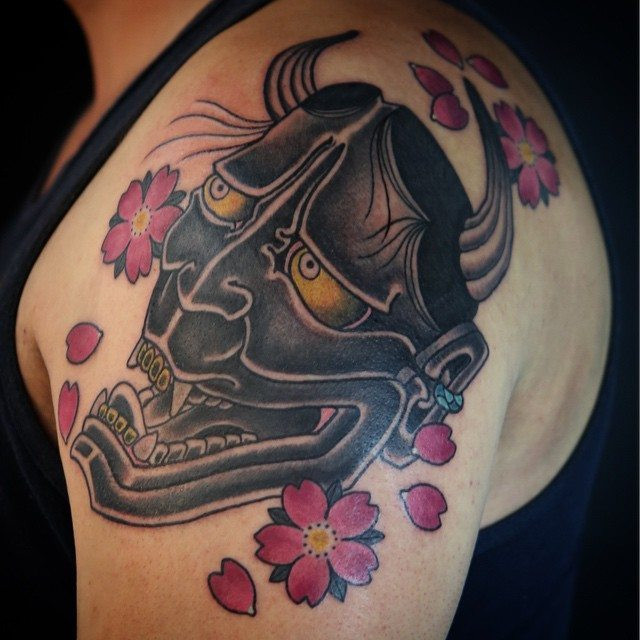 Hannya mask and cherry blossoms by Enku Shoji
Hannya mask and cherry blossoms by Enku Shoji
1.2 Lotus Flower (Hasu)
The lotus flower rises from murky waters to bloom in pristine beauty, symbolizing purity, spiritual awakening, and truth. It is believed that the lotus represents faith, harmony, and the journey of the soul toward enlightenment. Often paired with watery themes, such as koi fish or water deities, the lotus flower in a tattoo can signify overcoming adversity and achieving inner peace. According to Inked Magazine, the lotus is a popular choice for those seeking to express their spiritual growth and resilience.
 Koi and lotus half sleeve by Ning Chula
Koi and lotus half sleeve by Ning Chula
1.3 Peony (Botan)
Peonies are symbols of wealth, good fortune, prosperity, and beauty. They represent courage, honor, and nobility, making them a popular choice for those seeking to attract positive energy and success. Peonies also embody the idea that great rewards come from taking great risks, reflecting a bold and adventurous spirit. According to a study by the Japanese Tattoo Historical Society, the peony gained popularity during the Edo period as a symbol of affluence and high social status.
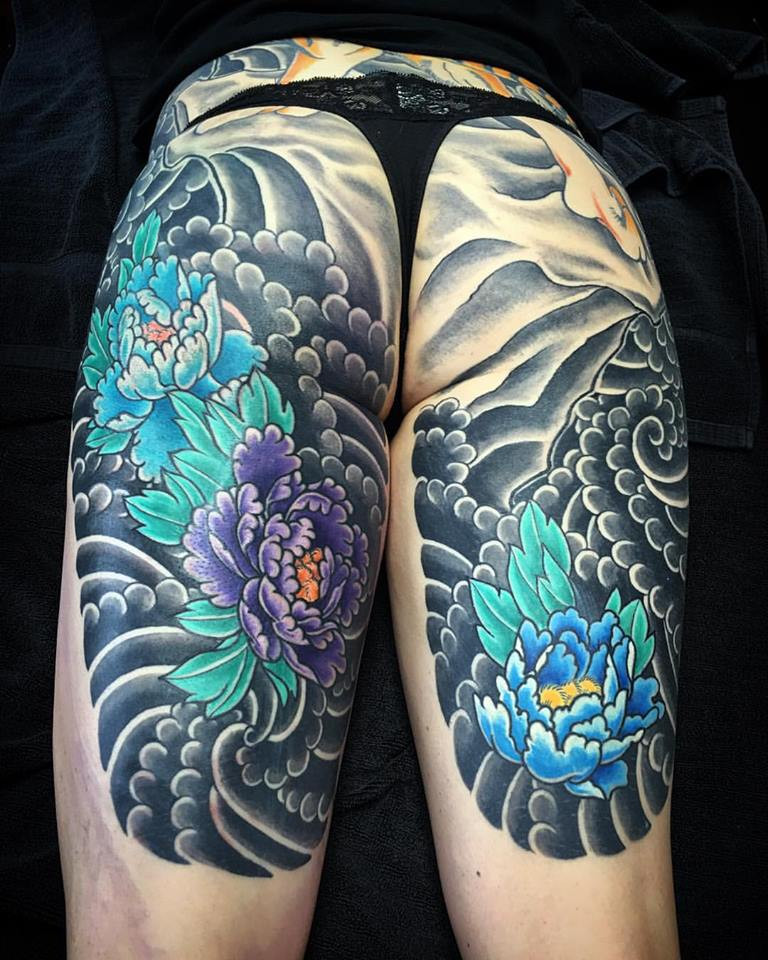 Peonies on the back of thighs, as part of a full Tiger Back Piece, by Kian Horisumi Forreal
Peonies on the back of thighs, as part of a full Tiger Back Piece, by Kian Horisumi Forreal
1.4 Chrysanthemum (Kiku)
The chrysanthemum is associated with royalty and perfection. It represents happiness, joy, and longevity, and is often referred to as the “King of Flowers”. Chrysanthemums symbolize the desire for a long and fulfilling life, as well as a connection to Japanese heritage and tradition. The Japanese emperor traditionally sits on the Chrysanthemum Throne. As noted by renowned tattoo artist Horiyoshi III, the chrysanthemum’s intricate petals and vibrant colors make it a visually stunning and symbolically rich choice for tattoos.
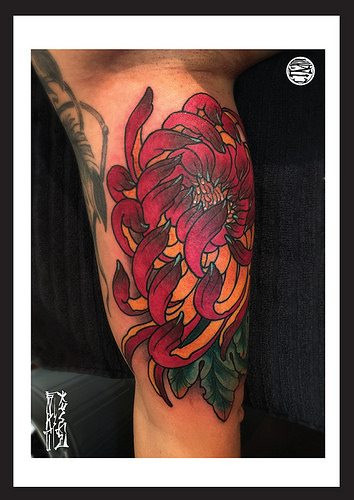 Chrysanthemum piece by Enku Shoji
Chrysanthemum piece by Enku Shoji
1.5 Maple Leaf (Momiji)
In traditional Japanese tattoos, maple leaves symbolize love, peace, and harmony. Unlike Western interpretations, where maple leaves may represent Canada or simply autumnal beauty, Japanese maple leaves carry deeper emotional and philosophical meanings. They signify the transience of time and the beauty of change, often depicted in autumnal colors ranging from greens to reds. The maple leaf can evoke feelings of nostalgia, serenity, and a deep connection to nature. According to tattoo historian Donald Richie, the integration of maple leaves into Japanese tattoos reflects a reverence for the natural world and its cycles.
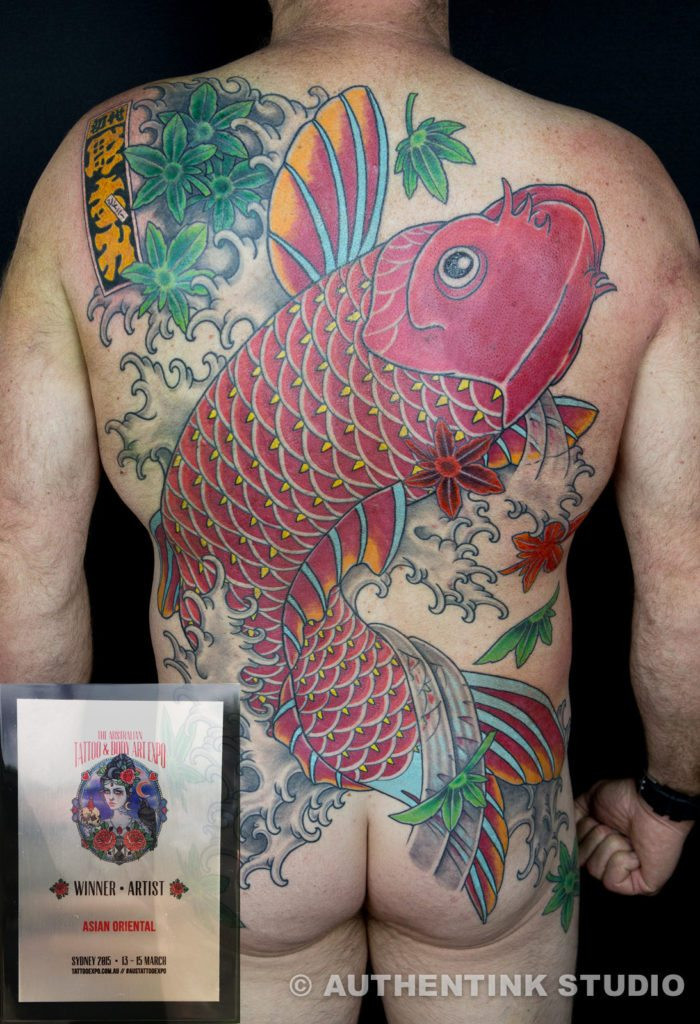 Full koi back piece with Maple leaves, by Kian Horisumi Forreal
Full koi back piece with Maple leaves, by Kian Horisumi Forreal
2. What are Popular Combinations of Japanese Blossom Flower Tattoos?
Popular combinations of Japanese blossom flower tattoos often pair floral elements with traditional Japanese motifs like koi fish, dragons, and mythical creatures to enhance the tattoo’s symbolism and visual appeal. These combinations create harmonious and meaningful designs that tell a story or represent specific aspects of the wearer’s life.
2.1 Cherry Blossoms and Koi Fish
Pairing cherry blossoms with koi fish creates a harmonious balance between the ephemeral beauty of the blossoms and the strength and perseverance of the koi. This combination symbolizes the journey of life, overcoming obstacles, and achieving success while appreciating the fleeting moments of beauty along the way.
 Koi sleeve with water and cherry blossoms by Ning Chula
Koi sleeve with water and cherry blossoms by Ning Chula
2.2 Lotus Flower and Dragon
Combining the lotus flower with a dragon merges the symbolism of purity and spiritual awakening with power and wisdom. This combination represents the transformation of the soul and the ability to rise above challenges with grace and strength.
2.3 Peony and Tiger
The peony and tiger combination symbolizes the balance between beauty and power. The peony represents wealth and prosperity, while the tiger embodies courage and protection. Together, they signify that strength and beauty can coexist, creating a harmonious and powerful image.
2.4 Chrysanthemum and Dragon
Pairing the chrysanthemum with a dragon combines the symbolism of royalty, perfection, and longevity with strength and wisdom. This combination can represent the desire for a long, fulfilling life filled with honor and integrity. According to Japanese folklore, dragons are often seen as guardians of emperors, making this pairing a symbol of protection and noble leadership.
2.5 Maple Leaves and Kappa
Combining maple leaves with a Kappa, a mythical water spirit, creates a tattoo that represents love, peace, harmony, and a connection to the natural world. This combination symbolizes the appreciation for nature, the transience of time, and the importance of living in harmony with one’s surroundings.
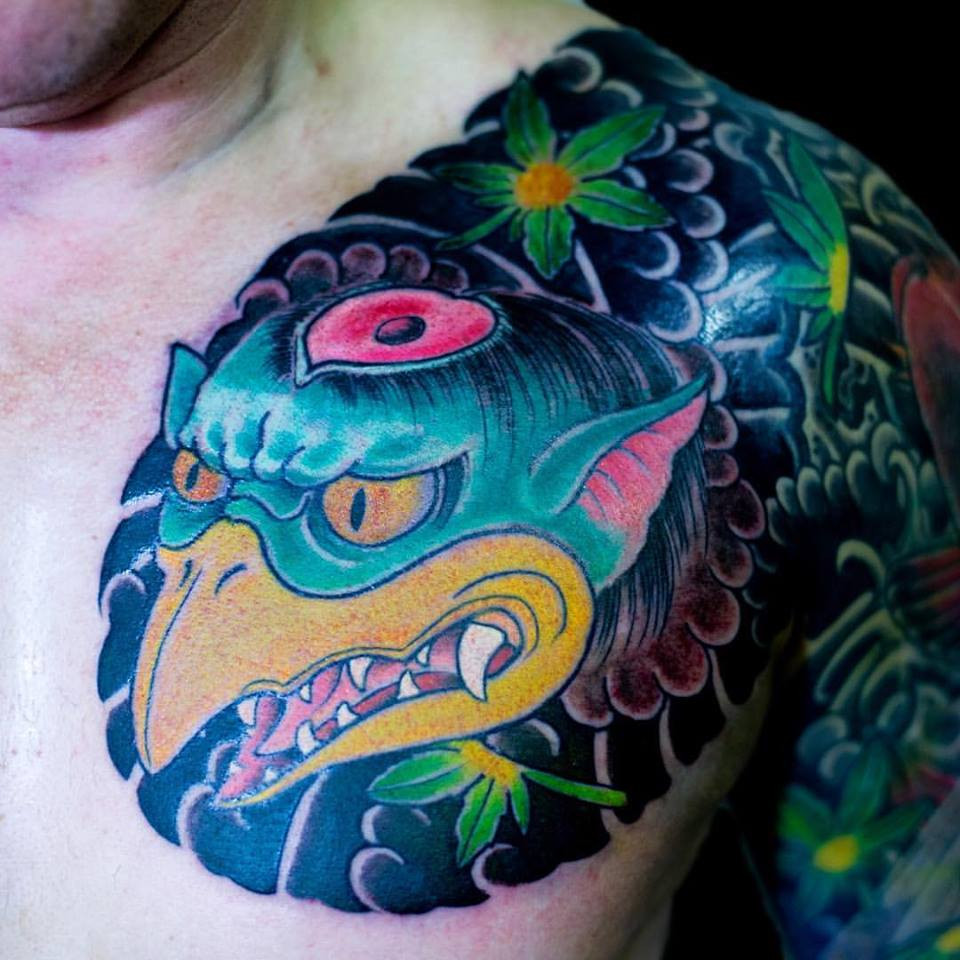 Kappa chest plate with maple leaves by Kian Horisumi Forreal
Kappa chest plate with maple leaves by Kian Horisumi Forreal
3. How Do I Choose the Right Artist for My Japanese Blossom Flower Tattoo?
Choosing the right artist for your Japanese blossom flower tattoo is essential to ensure that the design is executed with skill, precision, and cultural sensitivity. Look for an artist who specializes in Japanese traditional tattoo art and has a deep understanding of the symbolism and techniques involved.
3.1 Research and Portfolio Review
Start by researching artists who specialize in Japanese-style tattoos. Look at their portfolios to see examples of their work, paying attention to the quality of the lines, the use of color, and the overall composition. Do they have experience with the specific flower you want?
3.2 Check Reviews and Testimonials
Read reviews and testimonials from previous clients to get an idea of the artist’s reputation and professionalism. Look for feedback on their artistic abilities, their communication skills, and their commitment to hygiene and safety.
3.3 Consultation
Schedule a consultation with the artist to discuss your ideas and expectations. This is an opportunity to ask questions, share reference images, and get a sense of their artistic vision. A good artist will listen to your ideas and offer suggestions to improve the design while respecting your personal preferences.
3.4 Specialization in Japanese Traditional Tattoo Art
Ensure the artist has experience and expertise in Japanese traditional tattoo art. This includes understanding the specific techniques, color palettes, and symbolism associated with different floral motifs.
3.5 Cultural Sensitivity
Choose an artist who demonstrates cultural sensitivity and respect for Japanese traditions. This is important to ensure that the tattoo is not only aesthetically pleasing but also culturally meaningful and appropriate.
3.6 Hygiene and Safety Standards
Verify that the artist follows strict hygiene and safety standards. This includes using sterile equipment, wearing gloves, and maintaining a clean and sanitary work environment.
3.7 Tattooat.com Artist Directory
Explore tattooat.com’s directory of artists, which features a curated selection of talented professionals specializing in various tattoo styles, including Japanese traditional art. Each artist’s profile includes a portfolio, reviews, and contact information, making it easy to find the perfect match for your needs.
4. What are the Key Elements of a Japanese Blossom Flower Tattoo Design?
Key elements of a Japanese blossom flower tattoo design include precise linework, vibrant colors, traditional motifs, and meaningful symbolism. These elements combine to create a visually stunning and culturally rich piece of art that reflects the wearer’s personal values and beliefs.
4.1 Linework
Precise linework is essential for creating clean, crisp designs that stand the test of time. Bold outlines and intricate details help to define the shape and form of the flowers, creating a sense of depth and dimension.
4.2 Color Palette
Vibrant colors are often used in Japanese blossom flower tattoos to enhance their visual appeal and symbolism. Traditional color palettes include shades of red, pink, purple, and gold, each carrying its own unique meaning and significance.
4.3 Traditional Motifs
Incorporating traditional Japanese motifs, such as waves, clouds, and wind bars, can add depth and context to the design. These elements help to create a sense of movement and flow, enhancing the overall composition and storytelling of the tattoo.
4.4 Symbolism
Understanding the symbolism of different flowers and motifs is crucial for creating a meaningful tattoo. Each element should be carefully chosen to reflect the wearer’s personal values, beliefs, and experiences.
4.5 Composition
The overall composition of the tattoo should be balanced and harmonious, with each element working together to create a cohesive and visually appealing design. Consider the placement of the tattoo on the body and how it will flow with the natural contours and curves.
4.6 Floral Variety
Combining different types of blossoms can create a more intricate and layered design. Mixing cherry blossoms with lotus flowers or peonies can add depth and complexity to the tattoo’s symbolism.
5. Where are the Best Placements for Japanese Blossom Flower Tattoos?
The best placements for Japanese blossom flower tattoos depend on the size, design, and personal preferences. Popular locations include the back, shoulder, arm, leg, and chest, each offering its own unique advantages and considerations.
5.1 Back
The back offers a large canvas for intricate and detailed designs, making it an ideal location for full back pieces or elaborate floral arrangements. It allows for a wide range of creative possibilities and can accommodate complex compositions.
5.2 Shoulder
The shoulder is a versatile placement that can showcase smaller, more delicate designs or serve as a starting point for a larger sleeve or chest piece. It offers good visibility and can be easily covered or revealed depending on the wearer’s preference.
5.3 Arm
The arm is a popular choice for both sleeves and smaller tattoos, offering a good balance between visibility and discretion. Floral designs can be wrapped around the arm to create a sense of movement and flow.
5.4 Leg
The leg provides ample space for larger designs, such as full leg sleeves or thigh tattoos. It is a good option for those who want to showcase their ink but also have the option to cover it up.
5.5 Chest
The chest is a bold and expressive placement that can be used to create striking and symmetrical designs. Floral motifs can be incorporated into chest plates or used to accentuate the natural curves of the body.
5.6 Ribs
The ribs can be a visually stunning placement for Japanese blossom flower tattoos, offering a long, narrow canvas that can be used to create flowing, organic designs. This area is particularly well-suited for pieces that emphasize the natural curves of the body.
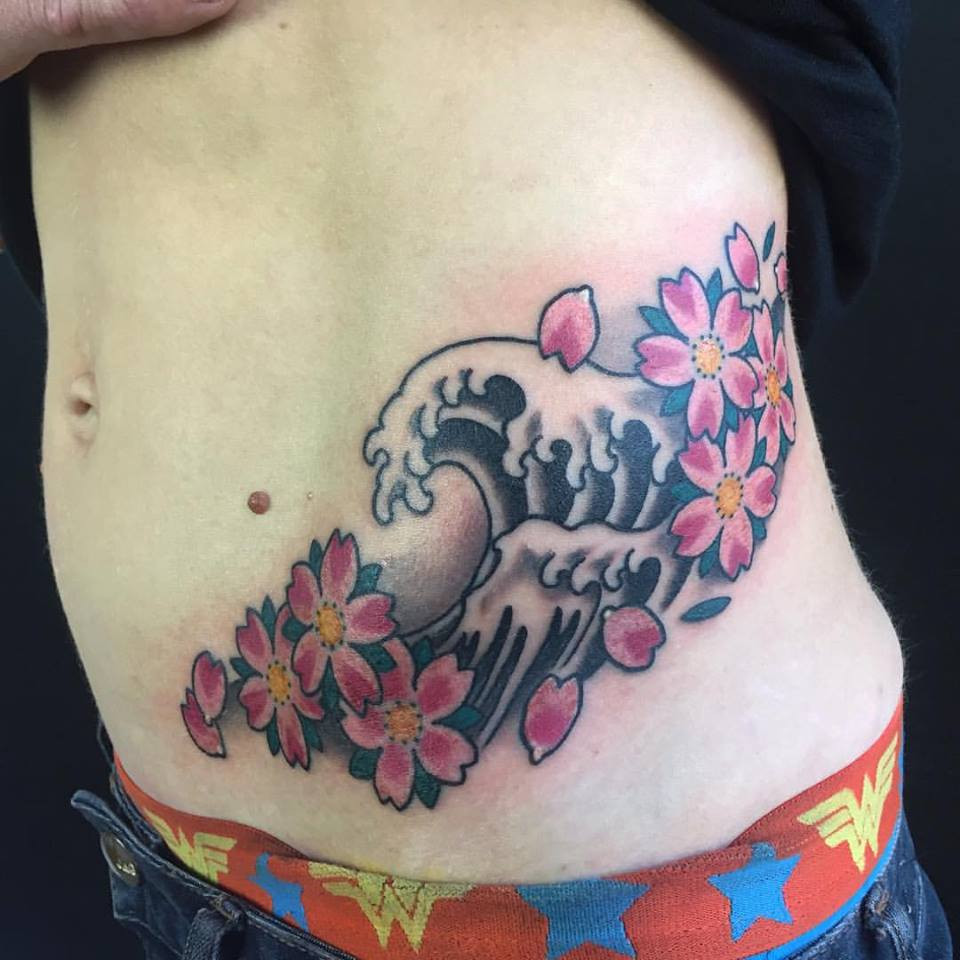 Cherry blossom and waves on ribs, by Enku Shoji
Cherry blossom and waves on ribs, by Enku Shoji
6. What Aftercare is Required for Japanese Blossom Flower Tattoos?
Proper aftercare is essential for ensuring that your Japanese blossom flower tattoo heals properly and remains vibrant for years to come. Follow these guidelines to protect your investment and maintain the beauty of your ink.
6.1 Keep the Tattoo Clean
Gently wash the tattoo with mild soap and warm water 2-3 times a day. Avoid using harsh chemicals, fragrances, or exfoliants.
6.2 Apply a Thin Layer of Moisturizer
Apply a thin layer of fragrance-free moisturizer to keep the skin hydrated and prevent scabbing. Avoid using petroleum-based products, which can clog the pores and interfere with the healing process.
6.3 Avoid Sun Exposure
Protect the tattoo from direct sunlight by wearing loose-fitting clothing or applying sunscreen with a high SPF. Sun exposure can cause the tattoo to fade over time.
6.4 Avoid Soaking the Tattoo
Avoid soaking the tattoo in water for extended periods, such as swimming, bathing, or using hot tubs. Prolonged exposure to water can increase the risk of infection and interfere with the healing process.
6.5 Do Not Pick or Scratch
Resist the urge to pick or scratch the tattoo, as this can damage the skin and increase the risk of infection. Allow the tattoo to heal naturally, and avoid any activities that could irritate the skin.
6.6 Stay Hydrated
Drink plenty of water to keep your skin hydrated and promote healing. A healthy diet and lifestyle can also support the healing process.
6.7 Consult Your Artist
Follow your artist’s specific aftercare instructions, and consult them if you have any questions or concerns. They can provide personalized advice and guidance based on your individual needs.
7. How Can I Personalize My Japanese Blossom Flower Tattoo Design?
Personalizing your Japanese blossom flower tattoo design involves incorporating elements that reflect your unique personality, experiences, and values. This can be achieved by adding personal symbols, customizing the color palette, or combining different floral motifs to create a meaningful and expressive piece of art.
7.1 Incorporate Personal Symbols
Add personal symbols that hold special meaning for you, such as birthstones, astrological signs, or meaningful dates. These elements can be subtly integrated into the design to create a more personal and intimate connection.
7.2 Customize the Color Palette
Customize the color palette to reflect your personal preferences and style. Choose colors that resonate with you and complement your skin tone. Consider using different shades and hues to create depth and dimension.
7.3 Combine Different Floral Motifs
Combine different floral motifs to create a unique and layered design. Mixing cherry blossoms with lotus flowers or peonies can add depth and complexity to the tattoo’s symbolism.
7.4 Add Calligraphy
Incorporate Japanese calligraphy to add a personal message or quote to the tattoo. Choose words that inspire you or reflect your personal values.
7.5 Integrate Family Crests
Integrate family crests or mon to honor your heritage and lineage. These symbols can be subtly incorporated into the design to create a connection to your family history.
7.6 Consultation with the Artist
Work closely with your artist to develop a personalized design that reflects your unique vision and style. Share your ideas and inspirations, and allow them to guide you in creating a tattoo that is both meaningful and aesthetically pleasing.
8. What are the Current Trends in Japanese Blossom Flower Tattoos?
Current trends in Japanese blossom flower tattoos include incorporating watercolor effects, minimalist designs, and neo-traditional styles. These trends reflect a desire for more modern and expressive interpretations of traditional Japanese art.
8.1 Watercolor Effects
Watercolor effects add a soft and ethereal quality to Japanese blossom flower tattoos, creating a dreamy and romantic aesthetic. This technique involves using subtle gradients and blended colors to mimic the look of watercolor paintings.
8.2 Minimalist Designs
Minimalist designs focus on simplicity and clean lines, creating a more understated and elegant look. These tattoos often feature delicate floral motifs with minimal shading and detail.
8.3 Neo-Traditional Styles
Neo-traditional styles blend traditional Japanese motifs with modern techniques and aesthetics. These tattoos often feature bold outlines, vibrant colors, and intricate details, creating a contemporary twist on classic designs.
8.4 Geometric Elements
Incorporating geometric elements, such as lines, shapes, and patterns, can add a modern and edgy touch to Japanese blossom flower tattoos. These elements can be used to create contrast and visual interest, enhancing the overall composition.
8.5 Black and Grey Realism
Black and grey realism is gaining popularity as a way to create more lifelike and detailed Japanese blossom flower tattoos. This technique involves using shading and highlights to create a sense of depth and dimension, resulting in a highly realistic and visually stunning piece of art.
9. How Do Japanese Blossom Flower Tattoos Reflect Cultural Values?
Japanese blossom flower tattoos reflect cultural values by embodying traditional symbolism, aesthetics, and philosophical concepts. These tattoos often serve as a way to honor Japanese heritage, express personal values, and connect with the natural world.
9.1 Symbolism
The symbolism of different flowers and motifs in Japanese tattoos reflects cultural values such as beauty, purity, courage, and longevity. Each element is carefully chosen to convey a specific message or meaning.
9.2 Aesthetics
The aesthetics of Japanese tattoos, including precise linework, vibrant colors, and balanced compositions, reflect a deep appreciation for beauty and harmony. These tattoos are designed to be visually pleasing and aesthetically timeless.
9.3 Philosophical Concepts
Japanese tattoos often incorporate philosophical concepts such as the transience of life, the importance of balance, and the interconnectedness of all things. These concepts reflect a deep understanding of the natural world and the human condition.
9.4 Honor and Respect
Wearing a Japanese tattoo can be a way to honor Japanese culture and traditions, as well as express respect for the artists who create these beautiful works of art. It can also be a way to connect with one’s own heritage and lineage.
9.5 Personal Expression
Japanese tattoos allow individuals to express their personal values, beliefs, and experiences in a meaningful and creative way. These tattoos can serve as a reminder of important life lessons, personal goals, and cherished memories.
10. Where Can I Find Inspiration and Resources for Japanese Blossom Flower Tattoos?
You can find inspiration and resources for Japanese blossom flower tattoos through online galleries, social media platforms, tattoo conventions, and tattooat.com. These resources offer a wealth of ideas, designs, and artist profiles to help you create the perfect tattoo.
10.1 Online Galleries
Explore online galleries and tattoo websites to browse a wide range of Japanese blossom flower tattoo designs. Look for inspiration in different styles, color palettes, and compositions.
10.2 Social Media Platforms
Follow tattoo artists and studios on social media platforms like Instagram and Pinterest to stay up-to-date on the latest trends and designs. These platforms offer a visual feast of inspiration and can help you discover new artists and styles.
10.3 Tattoo Conventions
Attend tattoo conventions and festivals to meet artists, see their work in person, and get inspired by the creativity and artistry on display. These events offer a unique opportunity to connect with the tattoo community and learn more about the art form.
10.4 Tattooat.com
Visit tattooat.com to explore a curated collection of Japanese blossom flower tattoos, discover talented artists, and learn about the history and symbolism of Japanese tattooing. Our website is a comprehensive resource for all things tattoo-related, offering inspiration, education, and guidance.
10.5 Books and Magazines
Read books and magazines about Japanese tattooing to learn more about the history, culture, and techniques involved. These resources offer in-depth information and insights from experts in the field.
10.6 Museums and Art Galleries
Visit museums and art galleries to see examples of Japanese art and culture that have influenced tattoo design. This can provide a deeper understanding of the aesthetics and symbolism of Japanese tattooing.
Japanese blossom flower tattoos offer a beautiful and meaningful way to express personal values and connect with Japanese culture. Whether you choose a delicate cherry blossom, a serene lotus flower, or a vibrant peony, your tattoo will be a lasting work of art that reflects your unique style and vision. At tattooat.com, we’re here to help you find the perfect design, connect with talented artists, and learn essential aftercare tips to ensure your tattoo remains a vibrant expression of your individuality for years to come.
Ready to start your tattoo journey? Explore our extensive collection of designs, discover talented artists near you, and dive into our informative articles about Japanese tattooing at tattooat.com. Let us help you bring your dream tattoo to life!
FAQ: Japanese Blossom Flower Tattoos
1. What do cherry blossom tattoos symbolize?
Cherry blossom tattoos symbolize beauty, the fragility of life, and the fleeting nature of existence. They often represent life after illness or honor a lost love.
2. What does a lotus flower tattoo mean?
A lotus flower tattoo represents purity, spiritual awakening, truth, faith, harmony, and the journey of the soul toward enlightenment.
3. What is the significance of peony tattoos?
Peony tattoos symbolize wealth, good fortune, prosperity, beauty, courage, honor, and nobility. They also depict that getting great rewards is only possible by taking great risks.
4. What does a chrysanthemum tattoo represent?
A chrysanthemum tattoo represents royalty, perfection, happiness, joy, and longevity. It is also known as the “King of Flowers”.
5. What does a maple leaf tattoo symbolize in Japanese culture?
In traditional Japanese tattoos, maple leaves symbolize love, peace, harmony, and the transience of time.
6. Can I combine different types of blossom flowers in one tattoo?
Yes, combining different types of blossom flowers can create a more intricate and layered design, adding depth and complexity to the tattoo’s symbolism.
7. How important is it to find an artist specializing in Japanese tattoos?
It is crucial to find an artist specializing in Japanese tattoos to ensure the design is executed with skill, precision, and cultural sensitivity.
8. What are some popular placements for Japanese blossom flower tattoos?
Popular placements include the back, shoulder, arm, leg, chest, and ribs.
9. How can I ensure my Japanese blossom flower tattoo heals properly?
Ensure your tattoo heals properly by keeping it clean, applying a thin layer of moisturizer, avoiding sun exposure, and following your artist’s aftercare instructions.
10. Where can I find inspiration for my Japanese blossom flower tattoo?
You can find inspiration through online galleries, social media platforms, tattoo conventions, and tattooat.com.
Address: 1825 SW Broadway, Portland, OR 97201, United States.
Phone: +1 (503) 725-3000.
Website: tattooat.com.
